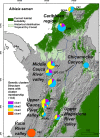Genetic diversity of the rain tree (Albizia saman) in Colombian seasonally dry tropical forest for informing conservation and restoration interventions
- PMID: 32128124
- PMCID: PMC7042685
- DOI: 10.1002/ece3.6005
Genetic diversity of the rain tree (Albizia saman) in Colombian seasonally dry tropical forest for informing conservation and restoration interventions
Abstract
Albizia saman is a multipurpose tree species of seasonally dry tropical forests (SDTFs) of Mesoamerica and northern South America typically cultivated in silvopastoral and other agroforestry systems around the world, a trend that is bound to increase in light of multimillion hectare commitments for forest and landscape restoration. The effective conservation and sustainable use of A. saman requires detailed knowledge of its genetic diversity across its native distribution range of which surprisingly little is known to date. We assessed the genetic diversity and structure of A.saman across twelve representative locations of SDTF in Colombia, and how they may have been shaped by past climatic changes and human influence. We found four different genetic groups which may be the result of differentiation due to isolation of populations in preglacial times. The current distribution and mixture of genetic groups across STDF fragments we observed might be the result of range expansion of SDTFs during the last glacial period followed by range contraction during the Holocene and human-influenced movement of germplasm associated with cattle ranching. Despite the fragmented state of the presumed natural A. saman stands we sampled, we did not find any signs of inbreeding, suggesting that gene flow is not jeopardized in humanized landscapes. However, further research is needed to assess potential deleterious effects of fragmentation on progeny. Climate change is not expected to seriously threaten the in situ persistence of A. saman populations and might present opportunities for future range expansion. However, the sourcing of germplasm for tree planting activities needs to be aligned with the genetic affinity of reference populations across the distribution of Colombian SDTFs. We identify priority source populations for in situ conservation based on their high genetic diversity, lack or limited signs of admixture, and/or genetic uniqueness.
Keywords: agroforestry; climate change; microsatellites; paleodistribution; seed zones; suitability modeling.
© 2020 The Authors. Ecology and Evolution published by John Wiley & Sons Ltd.
Conflict of interest statement
None declared.
Figures







Similar articles
-
Effects of Dry Tropical Forest Fragmentation on the Reproductive Success and Genetic Structure of the Tree Samanea saman.Conserv Biol. 2002 Feb;16(1):137-147. doi: 10.1046/j.1523-1739.2002.00317.x. Conserv Biol. 2002. PMID: 35701973
-
Coalescent Simulation and Paleodistribution Modeling for Tabebuia rosealba Do Not Support South American Dry Forest Refugia Hypothesis.PLoS One. 2016 Jul 26;11(7):e0159314. doi: 10.1371/journal.pone.0159314. eCollection 2016. PLoS One. 2016. PMID: 27458982 Free PMC article.
-
Tropical and subtropical Asia's valued tree species under threat.Conserv Biol. 2022 Jun;36(3):e13873. doi: 10.1111/cobi.13873. Epub 2022 Feb 14. Conserv Biol. 2022. PMID: 34865262
-
The contrasting nature of woody plant species in different neotropical forest biomes reflects differences in ecological stability.New Phytol. 2016 Apr;210(1):25-37. doi: 10.1111/nph.13724. Epub 2015 Nov 11. New Phytol. 2016. PMID: 26558891 Review.
-
A review on the indigenous multipurpose agroforestry tree species in Ethiopia: management, their productive and service roles and constraints.Heliyon. 2021 Aug 25;7(9):e07874. doi: 10.1016/j.heliyon.2021.e07874. eCollection 2021 Sep. Heliyon. 2021. PMID: 34504969 Free PMC article. Review.
References
-
- Aguilar, R. , Quesada, M. , Ashworth, L. , Herrerias‐diego, Y. , & Lobo, J. (2008). Genetic consequences of habitat fragmentation in plant populations: Susceptible signals in plant traits and methodological approaches. Molecular Ecology, 17(24), 5177–5188. 10.1111/j.1365-294X.2008.03971.x - DOI - PubMed
-
- Allen, O. N. , & Allen, E. K. (1981). The Leguminosae. A source book of characteristics, uses and nodulation. Madison, USA: University of Wisconsin Press.
-
- Alzate‐Marin, A. L. , Guidugli, M. C. , Soriani, H. H. , Martinez, C. A. , & Mestriner, M. A. (2009). An efficient and rapid DNA minipreparation procedure suitable for PCR/SSR and RAPD analyses in tropical forest tree species. Brazilian Archives of Biology and Technology, 52(5), 1217–1224. 10.1590/S1516-89132009000500020 - DOI
-
- Azpilicueta, M. M. , Gallo, L. A. , van Zonneveld, M. , Thomas, E. , Moreno, C. , & Marchelli, P. (2013). Management of Nothofagus genetic resources: Definition of genetic zones based on a combination of nuclear and chloroplast marker data. Forest Ecology and Management, 302, 414–424. 10.1016/j.foreco.2013.03.037 - DOI
Associated data
LinkOut - more resources
Full Text Sources
Miscellaneous

